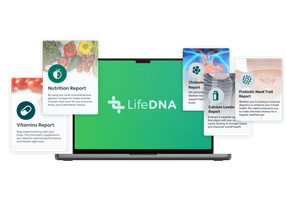Decoding Your Cravings: How Genes Shape Fatty Food Preferences
Aira
on
November 1, 2023
Latest Posts
Table of Contents
Decoding Your Cravings: How Genes Shape Fatty Food Preferences
Date of Content: October 6, 2023
Written by: Jess Gayo
Reviewed by: Maarit Tiirikainen, PhD
Overview
What Are Fatty Foods?
If you’ve ever craved a greasy pizza after a fun night out or wanted a good bite of the juicy ham at dinner, you are most likely familiar with how delicious fatty foods can be. Often deemed unhealthy, fats in general are essential to the human diet. It simply boils down to the type of fats you consume and their source.
A group of nutritional items known as “fatty foods” are distinguished by their high-fat content. Dietary fats are a crucial macronutrient that the body needs for several important processes. They are a concentrated source of energy, aid in the absorption of fat-soluble vitamins, and support many physiological functions. Foods’ flavor, texture, and satiety are all enhanced by fats.

Types of Fats and Their Palatability
Fatty foods can be broadly categorized into different types of fats, with the two primary categories being:
- Saturated Fats: These fats are frequently present in animal-based goods including meat, butter, and full-fat dairy, and are usually solid at room temperature. Saturated fats are also present in significant levels in some plant oils, such as coconut and palm oil.
- Food Sources: Saturated fats are commonly found in animal-based products like red meat, poultry, full-fat dairy products, and some plant oils like coconut oil and palm oil.
- Palatability: Saturated fats are known for their rich, creamy, and indulgent taste. They contribute to the mouthfeel, texture, and overall flavor of many foods, making them palatable. This palatability, however, can lead to overconsumption if not eaten in moderation.
- Unsaturated Fats: These fats are frequently seen as healthier and are typically liquid at room temperature. They can be further broken down into polyunsaturated fats (found in fatty fish, flaxseeds, and sunflower oil) and monounsaturated fats (found in olive oil, avocados, and nuts). Heart health is one of the many advantages of unsaturated fats in terms of health.
- Food Sources: Unsaturated fats are found in various plant-based oils (e.g., olive oil, canola oil), fatty fish (e.g., salmon, mackerel), nuts, seeds, and avocados.
- Palatability: Unsaturated fats can contribute to a mild, sometimes nutty, or fruity flavor in foods. While they may not offer the same level of richness and palatability as saturated fats, their subtler taste is often appreciated, especially in dishes where the flavor of the food itself is more prominent.
Saturated fats are frequently preferred when it comes to palatability because of their capacity to improve the flavor and texture of numerous foods. However, consuming too much saturated fats has been linked to adverse health effects, especially on the heart.
On the other hand, unsaturated fats are recommended in a balanced diet because of their favorable effects on heart health and general well-being. They are therefore seen as healthier alternatives. For taste and nutrition, it’s crucial to balance both types of fat in your diet, with an emphasis on decreasing saturated fat intake for optimum health.
Why Do People Crave Fatty Foods?
Interestingly, people often crave fatty foods for several reasons, both physiological and psychological. According to human evolution studies, calorie-dense foods, including fatty items, were essential for survival during times of scarcity. Early humans who craved and consumed high-energy foods were more likely to endure and reproduce, passing down their genes.
Fats also provide a concentrated source of energy, offering more than twice the calories per gram compared to carbohydrates and proteins. Cravings for fatty foods may signal the body’s need for an energy boost. Moreover, fatty foods are often rich, creamy, and flavorful, making them rewarding. The mouthfeel and taste of fats can trigger pleasure centers in the brain, leading to cravings.
While cravings for fatty foods are natural, try to strike a balance in your daily diet to ensure overall health. Moderation and mindful eating are key to enjoying fatty foods while maintaining a nutritious and well-rounded diet.
The Science Behind Fatty Food Preferences
Many factors, such as biology, culture, personal psychology, and environmental cues, have an impact on people’s preferences for fatty foods. People can preserve preferences that support general well-being by being aware of these influencing factors and making thoughtful food decisions.
Genetics Influencing Preference for Fatty Food
There is no single genetic marker that exclusively determines one’s preference for fatty foods. Instead, multiple genes and genetic variations collectively contribute to this complex trait.
CD36 Gene
Individuals’ perceptions of the flavor of lipids can be influenced by genetic variances in taste receptor genes. Differential perceptions of fat have been associated with the CD36 gene in particular. An individual’s sensitivity to the taste of fats and desire for fatty foods can be affected by variations in this gene.
TAS2R38 Gene
This gene encodes a taste receptor related to bitter taste perception. Genetic variations in TAS2R38 can influence how individuals perceive the taste of fatty foods and may affect their preferences.
DRD2 Gene
The DRD2 gene is associated with dopamine receptor D2, which plays a role in the brain’s reward pathways. Variations in this gene can influence how the brain responds to the consumption of rewarding foods, such as fast food, potentially also affecting fatty food preferences.
MC4R Gene
LEPR Gene
AGRP Gene
The Agouti-related protein (AGRP) affects appetite and can make you overeat if it’s added to your brain or if you have too much of it in your body. When scientists looked at two specific gene variations related to AGRP in different ethnic groups, they found interesting connections to how people eat. One study shows that these gene variations, previously connected to being lean, are also connected to the types of food people eat in different ethnic groups.
Other Genetic Markers
Other genetic markers in LifeDNA’s Preference for Fatty Foods Report include SNPs rs9939609 (FTO), rs1801282 (PPARG), rs2270188 (CAV2), and rs1800206 (PPARA).
The connections between genetics and dietary preferences are complicated, and these genetic markers only represent a small percentage of the genetic and physiological components involved in food preferences. In addition, lifestyle choices made by an individual, societal norms, and the environment all influence what they eat. More information regarding the genetic basis of food preferences, especially those for fatty meals, is likely to become available as this field of study develops.
Environmental Factors Influencing Preference for Fatty Food
Preference for fatty foods can be influenced by a variety of environmental factors. These external influences, in addition to genetic and physiological factors, play a significant role in shaping individual dietary choices. Here are some key environmental factors that can impact one’s preference for fatty foods:
Food Environment
- Food Availability: The availability and accessibility of fatty foods in the local food environment can strongly influence preferences. The prevalence of fast-food restaurants, convenience stores, and processed foods in a person’s surroundings can promote the consumption of fatty foods.
- Food Sensory Appeal: The sensory appeal of fatty foods, including their taste and texture, can be enhanced through food preparation techniques such as frying and baking. The sensory experience of these foods in restaurants and at home can contribute to preferences.
- Food Packaging and Presentation: The way fatty foods are packaged and presented in stores can affect preferences. Attractive packaging, appealing visuals, and food placement in stores can draw consumers toward high-fat options.
- Lack of Nutritional Education: Limited knowledge about the nutritional content and health implications of fatty foods can lead to less informed dietary choices, which may favor high-fat options.
- Marketing and Advertising: The marketing and advertising of fatty foods can create powerful incentives for consumption. Eye-catching advertisements and promotional strategies can make fatty foods more appealing and contribute to preferences.
Socio-Environmental Influences
- Family and Peer Influence: The dietary habits of family members and peer groups can shape individual food preferences. If family or friends often consume fatty foods, individuals are more likely to do the same.
- Cultural Influences: Cultural traditions and societal norms related to food can have a profound impact on food preferences. In some cultures, high-fat foods are a fundamental part of traditional dishes and celebrations, influencing preferences for these foods.
- Social Settings and Celebrations: Social gatherings and celebrations often feature foods high in fat, which can lead to an increased preference for these foods in a social context.
Personal Factors
- Emotional and Stress Eating: Emotional states and stress can lead to cravings for comfort foods, often high in fat. Emotional eating can be influenced by environmental stressors and emotional cues.
- Economic Factors: Economic factors, including the cost of food, can influence preferences. In some cases, high-calorie, energy-dense foods like fast food may be more affordable and accessible than healthier alternatives.
- Convenience and Time Constraints: Busy lifestyles and time constraints may lead individuals to opt for convenient, high-fat options when preparing healthier meals seems impractical.
These environmental factors can work in concert with genetic and physiological factors to shape food preferences. Recognizing and understanding these external influences is essential for making informed dietary choices and promoting healthier eating habits.
How Does Fatty Food Impact Health?
Fatty foods can have both positive and negative impacts on health, depending on the type and quantity of fats consumed.
Potential Positive Benefits
- Source of Energy: Fats are a concentrated source of energy, providing 9 calories per gram. They serve as a vital energy reserve, especially during prolonged physical activity or when carbohydrates are limited.
- Essential Nutrients: Dietary fats are essential for the absorption of fat-soluble vitamins (A, D, E, and K), which play crucial roles in various bodily functions.
- Brain Health: The brain is composed of a significant amount of fat, and dietary fats are essential for brain development and function. Omega-3 fatty acids, in particular, are associated with cognitive health.
Potential Negative Impacts
- Weight Gain and Obesity: Excessive consumption of high-fat, calorie-dense foods can contribute to weight gain and obesity. Weight management is crucial for overall health.
- Cardiovascular Health: Saturated and trans fats, often found in fried and processed foods, can raise levels of LDL cholesterol and increase the risk of heart disease and stroke.
- Metabolic Health: A diet high in saturated and trans fats can contribute to insulin resistance, increasing the risk of type 2 diabetes.
- Liver Health: Overconsumption of saturated fats may lead to non-alcoholic fatty liver disease (NAFLD), a condition characterized by fat accumulation in the liver.
- Inflammatory Response: Some types of fats, particularly trans fats, can promote inflammation in the body, which is linked to various chronic diseases.
- Digestive Issues: High-fat diets can cause digestive discomfort, including acid reflux, indigestion, and diarrhea.
- Joint Health: Some studies suggest a link between a high-fat diet and increased inflammation, which can contribute to joint pain in conditions like arthritis.
- Cognitive Health: Diets high in saturated and trans fats may negatively impact cognitive function and increase the risk of neurodegenerative diseases like Alzheimer’s.
- Mood and Mental Health: While omega-3 fatty acids can support mood and mental health, diets high in unhealthy fats may have the opposite effect, potentially contributing to mood disorders.
Maintaining a balanced intake of fats, choosing healthier options first, and consuming saturated and trans fats in moderation are the keys to a healthy diet. A well-balanced diet full of fresh produce, complete grains, lean meats, and healthy fats helps improve overall health. When choosing a diet, one should take into account their health circumstances and dietary requirements.
How to Lessen Fatty Food Preference
You can employ some strategies to decrease your preference for fatty foods. Remember that changing one’s eating preferences may take some time, but it is possible with perseverance and a sensible strategy.
Gradual Reduction
Sudden, drastic changes in your diet can be challenging to maintain. Start by gradually reducing your intake of fatty foods while introducing healthier alternatives. This approach allows your taste buds to adapt over time.
- Incorporate Healthy Fats: After gradually reducing unhealthy fats, slowly start to include sources of healthy fats in your diet, such as fats from avocados, nuts, seeds, and fatty fish. These options can satisfy your desire for fats while promoting overall health.
- Increase Whole Foods: Consume a variety of whole foods such as fruits, vegetables, whole grains, and lean proteins. These provide essential nutrients and can help balance your diet.
Mindful Eating
Pay attention to your eating habits. Eating mindfully can help you recognize feelings of fullness and satisfaction, making it easier to avoid overindulging in fatty foods.
- Educate Yourself: Learn about the health implications of excessive fat consumption, including its impact on weight, heart health, and overall well-being. Understanding the potential risks can motivate you to make healthier choices.
- Read Food Labels: Pay attention to food labels to identify and avoid products that are high in saturated and trans fats. Look for products with healthier fat profiles, such as those containing unsaturated fats.
- Cook at Home: Preparing meals at home gives you control over the ingredients you use. Opt for cooking methods that use less fat, such as grilling, baking, steaming, and sautéing with minimal oil.
- Substitute Ingredients: Find healthier alternatives for cooking and baking. For example, you can replace butter with applesauce in recipes, use Greek yogurt instead of sour cream, or opt for leaner cuts of meat.
Personal Choices and Habits
- Manage Stress: Stress and emotional factors can lead to cravings for comfort foods, including fatty options. Practice stress-reduction techniques, like meditation or yoga, to manage emotional eating.
- Seek Support: Discuss your dietary goals with a healthcare professional, nutritionist, or registered dietitian. They can offer personalized guidance and strategies to lessen your preference for fatty foods.
- Set Realistic Goals: Make achievable, realistic goals for your dietary changes. Small, sustainable steps are more effective than trying to eliminate fatty foods.
- Social Support: Let your friends and family know about your dietary goals so that they can offer support and encouragement. Social support can make it easier to stick to your plan.
Keep in mind that it is natural to enjoy the taste of fatty foods, and it’s not about eliminating them from your diet but rather finding a balance that promotes better overall health. Reducing your preference for fatty foods is a gradual process, and patience and consistency are key to long-term success.
LifeDNA’s Fatty Food Preference Report
Fats are essential to the human diet. Indulging in fatty foods now and then is normal but it is always best to strive for a well-balanced diet. LifeDNA’s Preference for Fatty Foods Report can help you understand why you always seem to crave fatty foods – or never seem to crave them, unlike most people. No matter your preference, your genes can tell you why and how your body reacts to dietary changes like adding or reducing fatty food intake.
Fats are not inherently bad. Keep in mind that the source of the fats and your daily intake is important when considering how to keep your preference for fatty foods in check. Whether your objective is to manage your weight, lower your blood sugar levels, or simply keep your body healthy, LifeDNA can help you. Try LifeDNA today.
Summary
- Although they are sometimes considered undesirable, fats in general are necessary for human nutrition. It all comes down to the kind of fats you eat and where they come from.
- Foods that are high in fat can be divided into two broad groups: saturated and unsaturated fats.
- Because they can enhance the flavor and texture of many dishes, saturated fats are typically preferred when it comes to palatability.
- Due to their benefits for heart health and overall well-being, unsaturated fats are suggested as a part of a balanced diet.
- Fats are frequently craved by people for a variety of physiological and psychological reasons.
- People’s preferences for fatty meals are influenced by a variety of factors, including biology, culture, personal psychology, and environmental cues.
- You can use a variety of tactics to reduce your appetite for fatty foods.
- A healthy diet revolves around maintaining a balanced intake of fats, prioritizing healthier options, and ingesting saturated and trans fats in moderation.
References
- https://www.nhs.uk/live-well/eat-well/food-types/different-fats-nutrition/
- https://www.health.harvard.edu/staying-healthy/know-the-facts-about-fats#:~:text=%22Fat%20helps%20give%20your%20body,your%20body%20absorb%20vital%20nutrients.
- https://www.hsph.harvard.edu/nutritionsource/what-should-you-eat/fats-and-cholesterol/types-of-fat/
- https://www.sciencedaily.com/releases/2012/02/120203113312.htm
- https://www.ncbi.nlm.nih.gov/books/NBK53528/
- https://www.frontiersin.org/articles/10.3389/fnut.2021.570401/full
- https://www.ncbi.nlm.nih.gov/pmc/articles/PMC9900072/
- https://www.ncbi.nlm.nih.gov/pmc/articles/PMC5022562/
- https://www.nature.com/articles/s41598-023-38988-9#:~:text=Variation%20in%20the%20melanocortin%2D4,occurrence%20of%20obesity15%2C16.
- https://www.ncbi.nlm.nih.gov/pmc/articles/PMC7230842/
- https://www.eufic.org/en/healthy-living/article/the-determinants-of-food-choice
- https://www.ncbi.nlm.nih.gov/books/NBK206912/
- https://www.nhs.uk/live-well/eat-well/food-types/different-fats-nutrition/#:~:text=Eating%20too%20much%20saturated%20fats,liver%2C%20where%20it’s%20disposed%20of.
- https://www.healthline.com/nutrition/greasy-food#4.-May-increase-your-risk-of-heart-disease-and-stroke
- https://www.health.harvard.edu/staying-healthy/know-the-facts-about-fats
- https://www.health.harvard.edu/staying-healthy/know-the-facts-about-fats
- https://www.nhs.uk/live-well/eat-well/how-to-eat-a-balanced-diet/eat-less-saturated-fat/
- https://www.texasheart.org/heart-health/heart-information-center/topics/14-simple-ways-to-reduce-saturated-fat/
- https://www.who.int/news-room/fact-sheets/detail/healthy-diet
- https://www.sciencedirect.com/science/article/pii/S0002916523296951?via%3Dihub
Customer Reviews




*Understanding your genetics can offer valuable insights into your well-being, but it is not deterministic. Your traits can be influenced by the complex interplay involving nature, lifestyle, family history, and others.
Our reports have not been evaluated by the Food and Drug Administration. The contents on our website and our reports are for informational purposes only, and are not intended to diagnose any medical condition, replace the advice of a healthcare professional, or provide any medical advice, diagnosis, or treatment. Consult with a healthcare professional before making any major lifestyle changes or if you have any other concerns about your results. The testimonials featured may have used more than one LifeDNA or LifeDNA vendors’ product or reports.































